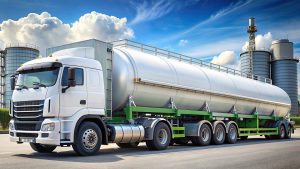Justin Coetzee, CEO and Founder of GoMetro
As the supply of fossil fuels declines, coupled with global acknowledgement of the associated environmental risks, the haulage industry has refocused its efforts on decarbonisation. If fleet managers are to end their reliance on oil and natural gas, they must look at alternative energy sources that are less harmful to the environment.
Fortunately, clean, renewable energy, by virtue of wind, water, and solar power, is becoming more accessible. Modes of transportation that rely on fossil fuels like cars, trucks, and aeroplanes are now being developed to run on renewable fuel sources.
The introduction of electric vehicle (EV) technology has been successful in the UK, with ZapMap reporting the existence of over 1,145,000 passenger and commercial EV’s on domestic roads as of June 2024.
A fully electric delivery fleet isn’t feasible just yet, but now is the time to plan and prepare for this future. Here are five steps that fleet managers can incorporate to ensure the smooth transition to an exclusively EV fleet.
1. Analyse your existing data
Start by examining your company’s existing operations. Gather information from your fleet telematics system on current routes, vehicle load capacity, typical cargo, and available drivers. Next, look at the quality of the road network around your premises and your vehicle replacement schedule. In-house telematics data will provide months of very rich operational insights to form the foundation of your transition strategy.
It can take some effort to pull all of this information together, but once it has been compiled and analysed, you will have a detailed overview of your operations. This will significantly assist you in the remaining steps of the process.
Although it is possible to complete this analysis in-house, getting help from experts will produce far more accurate results and an in-depth plan of action for the next steps.
2. Invest in solar
Despite the stereotype that the UK suffers from a distinct lack of sun across all seasons, solar power represents a renewable energy source that UK fleet operators should be looking to adopt on-site. There has been a huge push in the UK for solar panel installations, with the incoming Labour government revealing ambitious plans to invest £8.3 billion into state-owned power company Great British Energy (GBE). This investment is set to transform the energy landscape, which includes the expansion of solar power. One of the biggest incentives for businesses to invest in solar panels is the Investment Tax Credit (ITC), which allows them to deduct a percentage of their installation costs from their taxable income. This reduces the overall costs of going solar.
While there are appealing tax breaks, decision makers at haulage companies must apply strategic thinking to solar power adoption. Instead of investing in just enough roof panels to overcome power outages, entire roofs should be covered. Yes, it will produce more power than you can use right now, but that won’t be the case for long as later down the line, you’ll replace your fossil fuel costs with green, renewable ‘fuel’ to operate your fleet. Your solar investment will pay off in the long run, when highway electrification becomes more feasible for toll companies, and you can invest in larger trucks that can travel longer distances with more cargo.
3. Invest in your first electric vehicles
With the fleet telematics gathered in Step 1, investigate which electric trucks and vans will best suit your business. There are affordable entry-level EVs for most categories of commercial vehicle.
The initial analysis will identify the optimal balance of internal combustion engine (ICE) and EV vehicles in your fleet as an initial step towards transition. Then you need to decide which EVs are the most suitable replacements for the ICE vehicles nearing retirement.
Look at battery size, range, and charging times. Analyse how much solar power you are producing and compare those numbers to the energy requirements of various EVs. Match up your supply with potential demand for the best investment. Your EV fleet may look a little different from your ICE fleet, but it should ultimately produce the same results.
By the time you are ready to start replacing your ICE fleet, most likely with smaller delivery vehicles in the one-to four-tonne range, there will be a greater range of options to select from, as EV manufacturers are regularly launching new models and producing increasingly superior vehicles. Furthermore, import tariffs and duties could be adjusted in future government budget announcements, which will go a long way to the affordability of these eco-friendly vehicles.
4. Identify suitable routes
With a good understanding of your new vehicles’ capabilities, it is time to look at the most suitable routes to send them on. The first routes to be serviced by EVs will likely be loops of around 74 miles from the depot, and likely in Greater London, which has more than 20 000 EV charging points already. This will allow for two passes a day, with a fast charge after the first loop while the vehicle is being reloaded, and a full charge overnight on low-power charging.
Longer routes won’t be viable for some time as they will require charging infrastructure along major national routes, which will undoubtedly take a while to complete. However, shorter routes can reduce your fuel spend from the outset.
When the first tranche of your routes have gone electric and you’ve got new data to analyse – which routes work best, what the best charging schedule is for your business, your largest expenses and biggest savings, and so on – you can revisit your initial plan and make improvements for the next wave EVs you acquire.
5. Data management
Data management and analytics are even more important for EV fleets than ICE fleets. EV fleets require careful management of resources since you won’t be able to pop into a nearby fuelling station if a vehicle runs out of power.
One of the key benefits of data management and analytics for EV fleets is the ability to optimise charging infrastructure. Fleet managers who analyse data on vehicle usage patterns, charging times, and energy consumption, can identify the optimal locations for charging stations. This ensures that vehicles have convenient access to charging points and reduces the risk of downtime due to lack of power.
Monitoring battery health, energy consumption, and vehicle performance also lets fleet managers identify potential issues before they become major problems.
Thankfully, electric vehicles generate vast amounts of data that, with the assistance of a reliable electric vehicle fleet management system, will set your company up for a successful future in the EV era.
Anticipate further emissions regulations
The UK is currently aligned with the EU’s 2019/631 legislation, which introduced a zero and low emission benchmark of 15% of the vehicles in a manufacturers fleet for 2025. It’s only a matter of time before the government tightens these regulations even further, meaning fleet operators need to be proactive in introducing structural changes to ensure they are compliant with new laws.
An EV fleet is a neat solution to satisfying the developing standards of emissions control. Not only does it show commitment to a greener planet, but you can also take advantage of economic benefits, such as reduced fuel and maintenance costs, improved efficiency, and vehicle longevity, all of which are good for your business.






